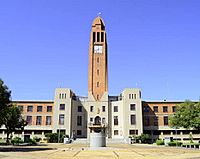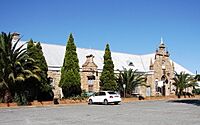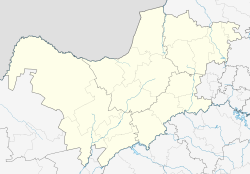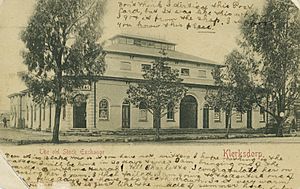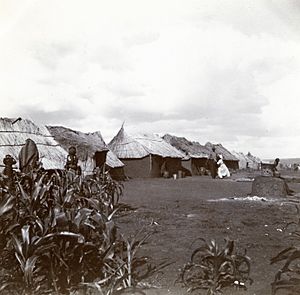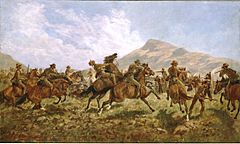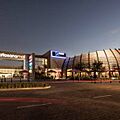Klerksdorp facts for kids
Quick facts for kids
Klerksdorp
City of Matlosana
|
|
|---|---|
|
City
|
|
|
Cityscape of Klerksdorp
|
|
| Country | |
| Province | |
| District | Dr Kenneth Kaunda |
| Municipality | City of Matlosana |
| Area | |
| • Total | 105.98 km2 (40.92 sq mi) |
| Population
(2011)
|
|
| • Total | 186,515 |
| • Density | 1,759.91/km2 (4,558.14/sq mi) |
| Racial makeup (2011) | |
| • Black African | 74.0% |
| • Coloured | 6.4% |
| • Indian/Asian | 1.3% |
| • White | 18.0% |
| • Other | 0.3% |
| First languages (2011) | |
| • Tswana | 42.7% |
| • Afrikaans | 23.8% |
| • Xhosa | 11.7% |
| • Sotho | 10.7% |
| • Other | 11.2% |
| Time zone | UTC+2 (SAST) |
| Postal code (street) |
2571
|
| PO box |
2570
|
| Area code | 018 |
| National Routes | |
| Provincial Routes | |
| Regional Routes | |
Klerksdorp is a city in the North West Province, South Africa. It is located about 165 kilometers southeast of Mahikeng, the provincial capital. Klerksdorp was once the first capital of the Transvaal Republic and had the first Stock Exchange in the region. It grew into an important trading town, connecting Kimberley and Johannesburg. The city became home to farmers, miners, and immigrants who supported these industries. Its location was chosen because of good water sources and a favorable climate.
Contents
History of Klerksdorp
Early Beginnings: 1837 and Beyond
Klerksdorp was founded in 1837 or 1838 by the Voortrekkers. These early settlers made their homes along the banks of the Schoonspruit, which means "Clear stream." This makes Klerksdorp the oldest European settlement north of the Vaal River. It was also the first settlement in the former Zuid-Afrikaansche Republiek (Z.A.R), also known as the Transvaal Republic.
A key early settler was Hendrik Grobler. He claimed a large farm and named it Elandsheuwel, meaning "Hill of the Eland." Grobler shared parts of his land with other Voortrekkers. In return, they helped him build a dam and an irrigation canal. This group of small farms was later named Klerksdorp. It honored Jacob de Clercq, who was the first landdrost (magistrate) of the area.
Becoming a City
Even though Klerksdorp was officially declared a town only in 1888, many people saw it as a town much earlier. Residents, visitors, and even government officials considered it a town.
In 1850, a traveler named Rev. A. Murray mentioned the "town on the Schoonspruit." In the same year, an official report called it the "town of Klerksdorp." This happened when residents asked for more land.
Seven years later, in 1857, a state attorney suggested that rules should be made for Klerksdorp. President M. W. Pretorius then created rules for Klerksdorp and Skoonspruit in 1859.
By 1863, the magistrate of Potchefstroom also referred to Klerksdorp as a town. In 1871, a map of the town was drawn. The town's rules were officially approved in 1872.
The Gold Rush of 1885
In November 1885, gold was found near Klerksdorp. This discovery happened around the same time gold was found on the Witwatersrand, about 160 kilometers to the east. Thousands of people hoping to get rich came to the small village. Klerksdorp quickly grew into a busy town with many taverns and its own stock exchange.
The stock exchange opened in 1888 and became very active. It sometimes sold the equivalent of R20,000 in one day. However, getting the gold out of the ground was difficult and needed expensive machines. Because of this, most gold seekers left in the late 1890s. This led to a decline in gold mining. The stock exchange closed and was later demolished in 1958. A new method for gold extraction, the MacArthur–Forrest process, brought a short boost in 1893. But problems like the Jameson Raid and a cattle disease called rinderpest caused the industry to almost collapse.
The Second Boer War (1899–1902)
During the Second Boer War (1899–1902), there was a lot of fighting in the Klerksdorp area. The region also had two large camps for displaced people. One camp was for white people, located where Klerksdorp High School is today. The other was for African people, in the areas now known as Ellaton and Neserhof.
One famous battle near Klerksdorp was the Battle of Ysterspruit ("Iron Stream"). In this battle, Boer general Koos de la Rey won a great victory. This battle is famous because Boer soldiers first used a new way of firing from horseback. On April 11, 1902, the Battle of Rooiwal, the last major fight of the war, happened near Klerksdorp. Here, British troops successfully defended against a Boer attack.
Today, you can visit the graves of those who died in these camps at the Old Cemetery Complex outside town. There are nearly a thousand graves there.
Desmond Tutu and Klerksdorp's Heritage
Klerksdorp is known as the birthplace of Anglican Archbishop Emeritus Desmond Mpilo Tutu. He was born here on October 7, 1931. In 1984, he received the Nobel Peace Prize. This award was for his efforts to create "a democratic and just society without racial divisions."
Desmond Tutu's life work was to help heal the divisions in South Africa. It is interesting that he was born in Klerksdorp, a place with many Boer monuments and old battlefields. These sites are linked to early settlers like Jacob de Clerq and the discovery of gold. Despite this history, Tutu worked to bring different groups together. He became a global role model for his achievements in uniting people.
Economic Growth Since 1932
The gold mining industry in Klerksdorp saw a new beginning in 1932. Large mining companies started operating during the Free State Gold Rush. This led to an economic boost for the town, which grew even faster after World War II.
Local Newspapers
Klerksdorp's first local newspaper, "The Klerksdorp Pioneer," started in 1887. It was later replaced by "The Representative" in 1888. Then, in 1899, H.M Guest's "Klerksdorp Mining Record" took over. This newspaper still exists today as the "Klerksdorp Record."
Klerksdorp's Economy
Early Trade and Mining
In 1865, James Taylor opened Klerksdorp's first trading store. In 1871, he partnered with Thomas Smith Leask, a former elephant hunter and trader. Their store, "Taylor and Leask," was the only one in Klerksdorp. It became a central spot for hunters and traders. They would bring ivory and animal skins from the "interior" (places like Matebeleland) and get supplies for their next trips.
In April 1890, a new gold recovery method called the McArthur-Forrest Cyanide Process was introduced. This process made it possible to get much more gold from the ore. This brought new hope and a revival to the mining industry. Even during tough times, some mines kept working, and farming also helped the town survive.
By the end of 1895, there were 25 mining companies. Gold production soared to 71,776 ounces. It seemed like the gold industry in Klerksdorp was strong and the difficult times were over.
Modern Economy Today
Klerksdorp, along with Rustenburg, is a key economic center in the North West Province. It is an important part of South Africa's gold mining industry. However, its importance has decreased in recent years. A big earthquake in March 2005 caused damage to the Stilfontein area and affected mining. Klerksdorp is also expected to become a large producer of uranium in the future.
Beyond mining, Klerksdorp is a major center for medical services, shopping, and education. It serves the North West Province and the Northern Free State.
The Klerksdorp area is also very important for South African agriculture. Crops like maize, sorghum, groundnuts, and sunflower are grown here. Klerksdorp is home to 'Senwes', which is the largest agricultural co-op in the southern hemisphere. The farming area is also known for its Sussex cattle herds. The city is the main office for the South African Sussex Cattle Breeders Association.
Many national government departments and agencies have offices in Klerksdorp. These include the SARS and the Department of Home Affairs.
Geography of Klerksdorp
Climate and Weather
Klerksdorp has a semi-arid climate. This means it has warm to hot summers and cool, dry winters. The average rainfall each year is about 482 millimeters. Most of this rain falls during the summer months.
| Weather chart for Klerksdorp | |||||||||||||||||||||||||||||||||||||||||||||||
|---|---|---|---|---|---|---|---|---|---|---|---|---|---|---|---|---|---|---|---|---|---|---|---|---|---|---|---|---|---|---|---|---|---|---|---|---|---|---|---|---|---|---|---|---|---|---|---|
| J | F | M | A | M | J | J | A | S | O | N | D | ||||||||||||||||||||||||||||||||||||
|
92
29
15
|
76
28
15
|
75
27
13
|
33
24
9
|
10
21
4
|
0
18
0
|
0
18
0
|
1
21
3
|
6
25
7
|
41
27
11
|
63
28
13
|
85
29
15
|
||||||||||||||||||||||||||||||||||||
| temperatures in °C precipitation totals in mm source: SA Explorer |
|||||||||||||||||||||||||||||||||||||||||||||||
|
Imperial conversion
|
|||||||||||||||||||||||||||||||||||||||||||||||
Neighborhoods and Suburbs
Klerksdorp is divided into 35 different neighborhoods, called suburbs.
List of suburbs
| Suburb | Suburb | Suburb |
|---|---|---|
| Adamayview | Alabama | Campbelldorp |
| Collerville | Dawkinsville | Doringkruin |
| Elandia | Elandsheuwel | Ellaton (New Industrial Area) |
| Flamwood | Flimieda | Freemanville |
| Irenepark | Jouberton | Lahoff |
| Meiringspark | Matlosane | Manzil Park |
| Neserhof | Oudorp | Pienaarsdorp |
| Randlespark | Roosheuwel | Songloed |
| Uraniaville (Old industrial area) | Wilkeville | Wilkoppies |
Jouberton: A Community's Journey
Klerksdorp's main residential area for black residents was first created in 1907. It was located south of the town, where the Neserhof and Ellaton suburbs are today. As early as 1924, there were talks about moving these residents. However, the move was put off due to financial issues.
In 1935 and 1936, the city council again decided to move them, but it did not happen. Finally, in 1949, construction began on the first houses in the new residential area, Jouberton. It was originally going to be named Joubertina, after councilor Jan Joubert. But because there was already a town with that name in the Cape Province, it was changed to Jouberton to avoid confusion.
Alabama: A New Home
The Colored community first lived next to the old industrial area. In 1956, the planning for Alabama, a new residential area, began. Two years later, in 1958, the construction of the new neighborhood started.
The Greater Klerksdorp Area
The larger area around Klerksdorp includes the towns of Orkney, Kanana, Stilfontein, Khuma, Hartbeesfontein, and Tigane. Together, these areas have a population of over 350,000 people.
Because these towns are close and connected, there have been discussions about combining Klerksdorp, Stilfontein, and Orkney since 1975. In 1979, a group was formed to study this idea. However, both Stilfontein and Orkney's city councils decided against combining in 1980.
Education in Klerksdorp
Klerksdorp has many schools for primary and secondary education. These include both public and private schools.
- Private schools: Klerksdorp Christian Academy, Curro Castle Klerksdorp, Methodist Primary School, Kingston Primary School, and Ashton John's School.
- Public schools: Klerksdorp Primary School, Hoërskool Klerksdorp, Technical High School, Hoërskool Schoonspruit, Goudkop Primary School, Milner High School, Wesvalia High School, Laerskool La Hoff, Janie Schneider School, Laerskool Saamtrek, Manzilpark Primary School, Laerskool Meiringspark, Keurhof School, and New Vision Secondary School.
Transportation in Klerksdorp
Airport Access
P.C Pelser Airport is a medium-sized airport in South Africa. It mainly serves private local residents in the Klerksdorp region.
For international and domestic flights, people from Klerksdorp usually use O.R Tambo International Airport.
Road Network
The N12 is a major highway that passes through Klerksdorp. The city is also connected by several regional roads. The R30 Road starts north of Bloemfontein Central and enters Klerksdorp as Church Street. It then meets the N12 Highway as Chris Hani Road. The R503 is another regional route. It connects Mahikeng with Klerksdorp, passing through Lichtenburg and Coligny.
Railway Connections
Klerksdorp's first rail connection was to Krugersdorp in 1897. The station was built by the Netherlands–South African Railway Company. President Kruger officially opened it on August 3, 1897. After the Anglo-Boer War, railway lines were extended to other parts of the country.
In 1905, the line was extended to Vierfontein and Kroonstad. In 1906, the Veertienstrome line opened, connecting Klerksdorp and Cape Town. In 1928, a link to Hartebeesfontein and Ottosdal was added.
City Infrastructure
Electricity Supply
The South African state-owned power company ESKOM operates several power stations in Klerksdorp. These stations provide electricity to different parts of the city.
| Substation | Suburbs Served |
|---|---|
| West | Roosheuwel, Freemanville, Elandia, Declerqville, Meiringspark, Songloed, Uraniaville, Oleander Park, Manzilpark, Alabama (Ext 1 & 2) |
| Jouberton | Jouberton, Tshepong Hospital, Alabama (Ext 3; 4 & 5) |
| Main | CBD, Randlespark, Ellaton, Neserhof, Klerkindustria, Oudorp Pienaarsdorp, Dawkinsville, N12 South (Senwes to CTM) |
| North | Doringkruin, Wilkoppies, Wilkeville, Irenepark, Lahoff, Adamayview, Flimieda, Gumtree |
After gold was discovered, people in Klerksdorp wanted electricity or gas. A company was given permission to supply electricity. However, due to problems in the gold mining industry, a cattle disease, and the Second Freedom War, citizens did not get these services early on.
The power station was later made bigger. In 1934, a new system was built. Ten years later, in 1944, the city council decided to stop running its own power station. Since then, electricity has been supplied by ESKOM.
Landmarks and Attractions
- Old Mining Shafts: You can still see mining shafts that were dug in the 1880s.
- The Klerksdorp Museum: This building was originally a prison, built in 1891. It was used as a prison until 1973. The warden's house now has exhibitions from different time periods. The museum also displays the Klerksdorp spheres. These are round objects that some people believe were made by humans a very long time ago.
- The Faan Meintjies Nature Reserve: Located about 15 kilometers from Klerksdorp, this reserve is home to 30 different types of game animals and 150 species of birds.
- The Oudorp Hiking Trail: This is a 12-kilometer long trail that goes through the oldest parts of the town.
- Goudkoppie (Gold Hill): This is a newer tourist attraction in the city. It is located near the N12 highway and the Johannesburg-Cape Town railway line.
- The Johan Neser Dam: Also known as Klerksdorp Dam, it is about 10 kilometers outside Klerksdorp on the road to Ventersdorp.
Rio Casino Resort
The Rio Casino Resort is inspired by the Brazilian city of Rio. It brings a carnival feeling to the area. At 24,743 square meters, it is one of the largest casinos in the Southern Hemisphere.
Matlosana Mall: A Shopping Hub
Matlosana Mall is the biggest shopping center in the North-West Province. It has 145 stores, including major retailers like Checkers, Pick n Pay, Woolworths, and Edgars. The mall offers fashion, lifestyle, sports stores, as well as entertainment and restaurants.
Protea Hotel Klerksdorp
| Klerksdorp Protea Hotel | |
|---|---|
| General information | |
| Address | Between Barand and Margaretha Prinsloo Streets, Klerksdorp, South Africa, 2571 |
| Opened | 1995 |
| Owner | Protea Hotels by Marriott |
| Other information | |
| Number of rooms | 91 |
| Number of restaurants | 1 (Pinotage Restaurant) |
| Facilities | 5 conference rooms |
Klerksdorp City Hall
The old municipal office building became too small over time. So, a new city office building was planned. On October 10, 1949, the first stone was laid by Dr. W. Nicol, the administrator of Transvaal. The building was finished in 1951.
Dr. T. E. Dönges, who was born in Klerksdorp and was then the Minister of Home Affairs, attended the official opening. The famous architect Gerhard Moerdyk designed the building. The last part of the complex, the town hall, was opened on February 19, 1963. C.R. Swart, the first State President of the Republic of South Africa, gave the opening speech.
Sports in Klerksdorp
The Harry Oppenheimer Stadium is located between Klerksdorp and Vaal River Operations. It is a popular sports field for athletics competitions for some of the bigger schools. The stadium was once considered as a possible host city for the 2010 FIFA World Cup. However, it lost its bid to the Rustenburg Royal Bafokeng Stadium.
Notable People from Klerksdorp
- Wiehahn Herbst (born 1988) - a rugby union player for the Tel Aviv Heat
- Marco Jansen - a South African cricketer
- Philemon Raul Masinga - a former professional footballer
- Ayanda Jiya - a singer
- Maglera Doe Boy - a rapper
- Joe McGluwa - a Member of Parliament at the National Assembly
Desmond Mpilo Tutu
Desmond Mpilo Tutu (October 7, 1931 – December 26, 2021) was a South African Anglican bishop and theologian. He was well-known for his work as an anti-apartheid and human rights activist. He was the first black African to hold the position of Bishop of Johannesburg (1985-1986) and then Archbishop of Cape Town (1986-1996). He combined ideas from black theology with African theology in his beliefs.
Herbert Melville Guest
Herbert Guest was the second Mayor of Klerksdorp. He served from 1910 to 1911, after the town became a municipality in 1903.
Healthcare in Klerksdorp
Klerksdorp has four private hospitals, which makes it an important medical center in the North West Province. Some hospitals offer advanced cancer treatment, attracting patients from all over the district.
Life Anncron Hospital
Life Anncron Hospital has five operating theaters. It also has several specialized intensive-care units and a 16-bed maternity unit. It is the only hospital in the central North West Province with a cardiology (heart care) facility.
Klerksdorp/Tshepong Hospital Complex
The Klerksdorp Tshepong Hospital Complex is a public hospital in Klerksdorp. Klerksdorp Hospital was built in 1896, and Tshepong hospital in 1978. In 1999, these two hospitals joined to become one large hospital complex.
Sunningdale Private Hospital
Sunningdale Private Hospital is located in a suburb of Klerksdorp.
Law Enforcement
The latest crime statistics for the Klerksdorp Police Precinct were released by the South African Police Service (SAPS) in September 2012. Compared to other major towns and cities in South Africa, Klerksdorp is still considered one of the safer places in the country.
The Klerksdorp District
The Klerksdorp district includes the towns of Klerksdorp, Hartbeesfontein, Orkney, and Stilfontein. Together, these towns are often called the KOSH-area.
Images for kids


